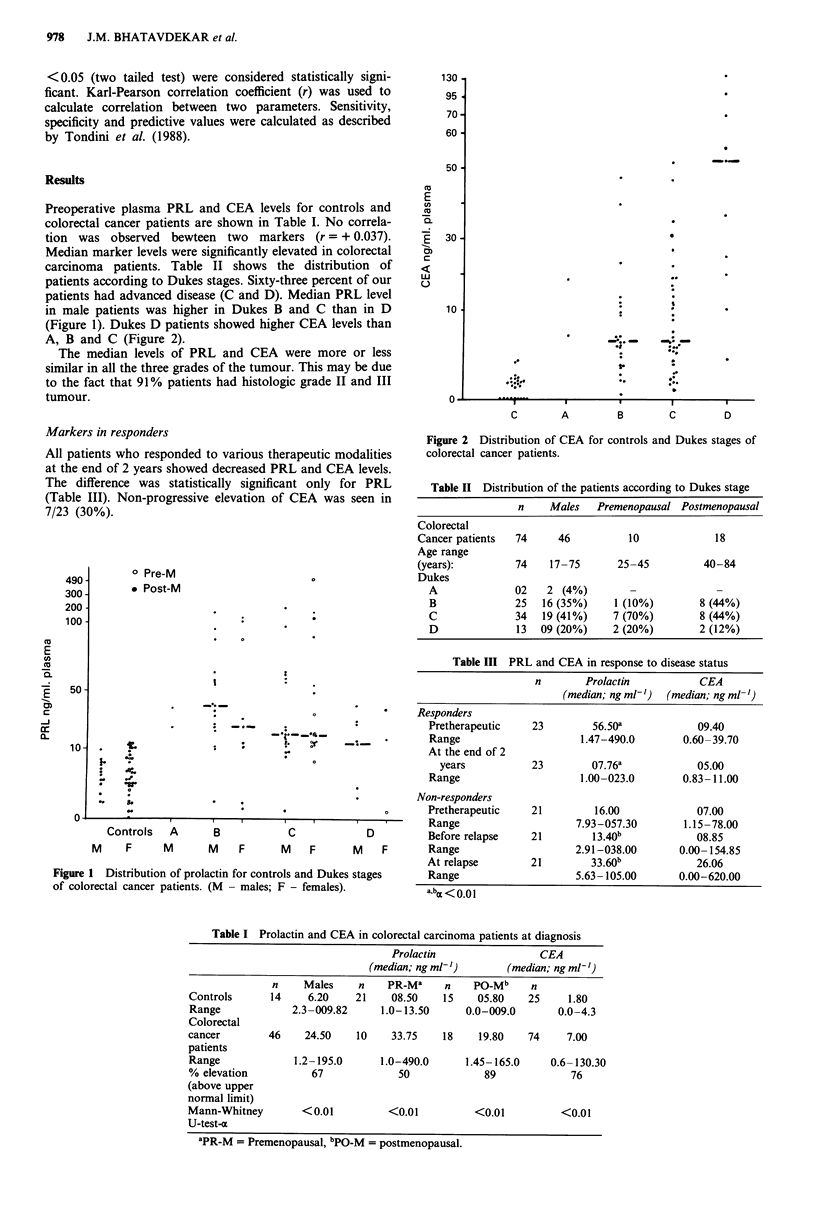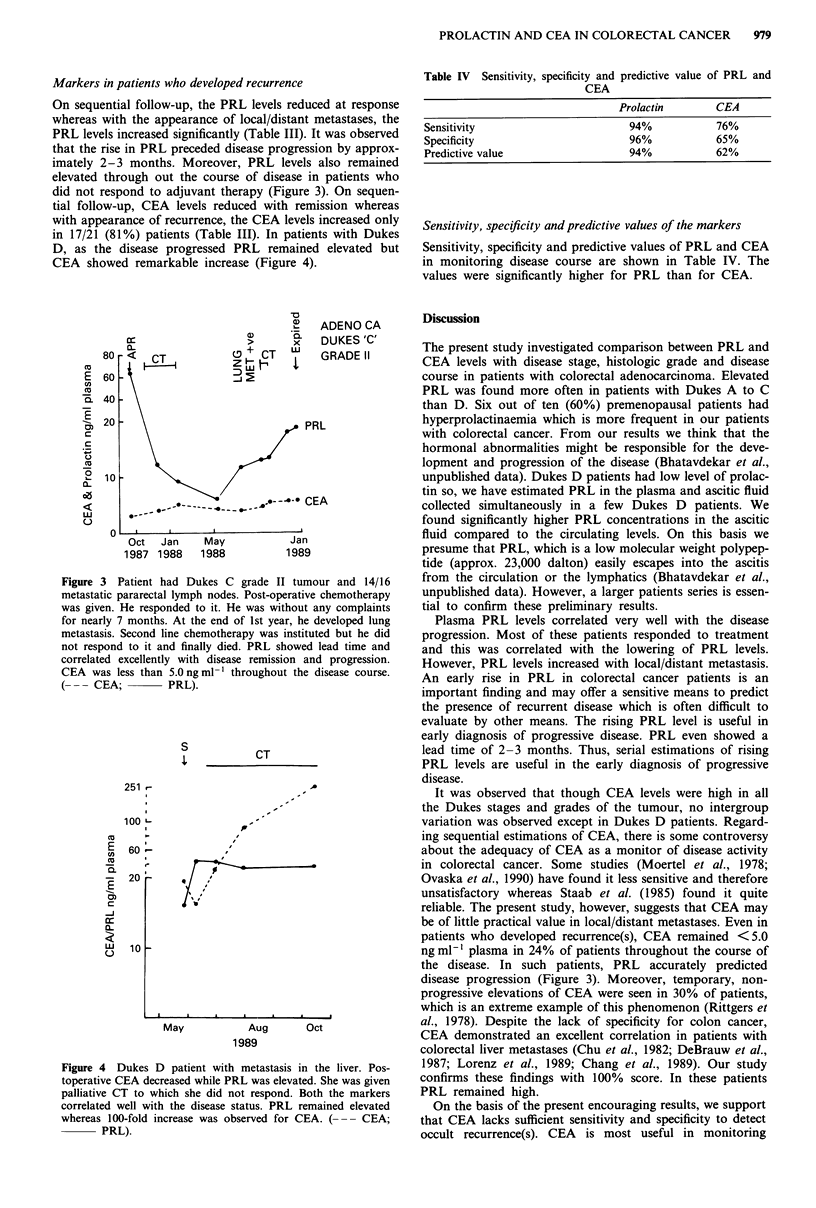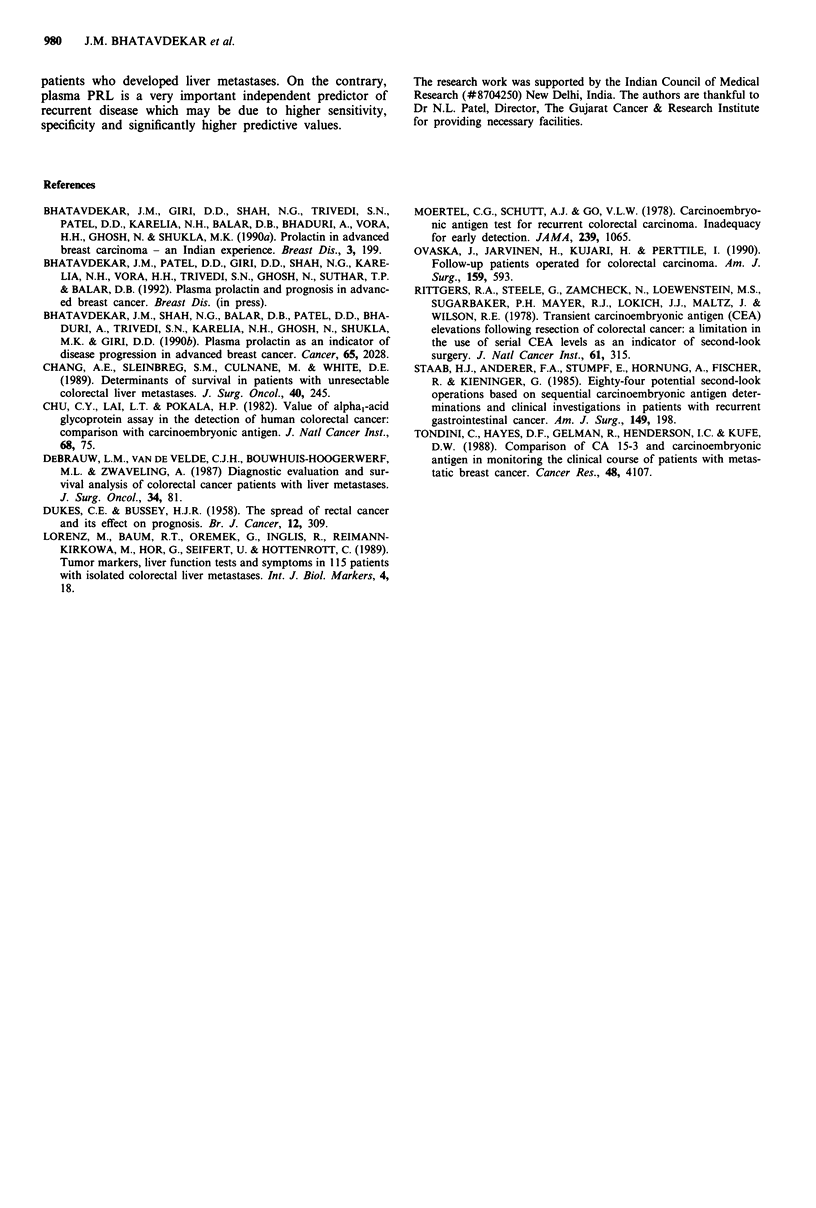Abstract
Plasma prolactin (PRL) and carcinoembryonic antigen (CEA) were measured by radioimmunoassay in 74 patients with adenocarcinoma of colon and rectum. The markers were correlated with disease stage, histological grade and progression/remission of disease. The circulating preoperative median PRL and CEA levels were significantly higher in colorectal cancer patients than in their respective controls. PRL was elevated in all Dukes stages and in all histological grades of the tumour whereas the rise in CEA was more pronounced in Dukes D. Out of 74 patients, 29% (21/74) developed recurrent disease and 31% (23/74) responded to the treatment. With regard to monitoring recurrence(s), the predictive value of PRL was 94% which was significantly greater than that of CEA which was only 62%. In patients who developed liver metastases PRL remained elevated whereas CEA showed more than 100-fold increase. Therefore, we feel that CEA is a better marker for monitoring patients who developed liver metastases. From our results, we suggest that PRL can be used as a better overall marker for detecting recurrence(s) in patients with colorectal adenocarcinoma.
Full text
PDF



Selected References
These references are in PubMed. This may not be the complete list of references from this article.
- Bhatavdekar J. M., Shah N. G., Balar D. B., Patel D. D., Bhaduri A., Trivedi S. N., Karelia N. H., Ghosh N., Shukla M. K., Giri D. D. Plasma prolactin as an indicator of disease progression in advanced breast cancer. Cancer. 1990 May 1;65(9):2028–2032. doi: 10.1002/1097-0142(19900501)65:9<2028::aid-cncr2820650924>3.0.co;2-9. [DOI] [PubMed] [Google Scholar]
- Chang A. E., Steinberg S. M., Culnane M., White D. E. Determinants of survival in patients with unresectable colorectal liver metastases. J Surg Oncol. 1989 Apr;40(4):245–251. doi: 10.1002/jso.2930400409. [DOI] [PubMed] [Google Scholar]
- Chu C. Y., Lai L. T., Pokala H. P. Value of plasma alpha-1-acid glycoprotein assay in the detection of human colorectal cancer: comparison with carcinoembryonic antigen. J Natl Cancer Inst. 1982 Jan;68(1):75–79. [PubMed] [Google Scholar]
- DUKES C. E., BUSSEY H. J. The spread of rectal cancer and its effect on prognosis. Br J Cancer. 1958 Sep;12(3):309–320. doi: 10.1038/bjc.1958.37. [DOI] [PMC free article] [PubMed] [Google Scholar]
- Lorenz M., Baum R. P., Oremek G., Inglis R., Reimann-Kirkowa M., Hör G., Seiffert U., Hottenrott C. Tumor markers, liver function tests and symptoms in 115 patients with isolated colorectal liver metastases. Int J Biol Markers. 1989 Jan-Mar;4(1):18–26. doi: 10.1177/172460088900400104. [DOI] [PubMed] [Google Scholar]
- Moertel C. G., Schutt A. J., Go V. L. Carcinoembryonic antigen test for recurrent colorectal carcinoma. Inadequacy for early detection. JAMA. 1978 Mar 13;239(11):1065–1066. [PubMed] [Google Scholar]
- Ovaska J., Järvinen H., Kujari H., Perttilä I., Mecklin J. P. Follow-up of patients operated on for colorectal carcinoma. Am J Surg. 1990 Jun;159(6):593–596. doi: 10.1016/s0002-9610(06)80074-7. [DOI] [PubMed] [Google Scholar]
- Rittgers R. A., Steele G., Jr, Zamcheck N., Loewenstein M. S., Sugarbaker P. H., Mayer R. J., Lokich J. J., Maltz J., Wilso R. E. Transient carcinoembryonic antigen (CEA) elevations following resection of colorectal cancer: a limitation in the use of serial CEA levels as an indicator for second-look surgery. J Natl Cancer Inst. 1978 Aug;61(2):315–318. [PubMed] [Google Scholar]
- Staab H. J., Anderer F. A., Stumpf E., Hornung A., Fischer R., Kieninger G. Eighty-four potential second-look operations based on sequential carcinoembryonic antigen determinations and clinical investigations in patients with recurrent gastrointestinal cancer. Am J Surg. 1985 Feb;149(2):198–204. doi: 10.1016/s0002-9610(85)80064-7. [DOI] [PubMed] [Google Scholar]
- Tondini C., Hayes D. F., Gelman R., Henderson I. C., Kufe D. W. Comparison of CA15-3 and carcinoembryonic antigen in monitoring the clinical course of patients with metastatic breast cancer. Cancer Res. 1988 Jul 15;48(14):4107–4112. [PubMed] [Google Scholar]


